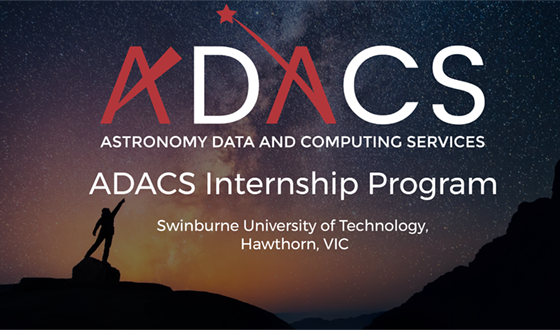
ADACS Internship Program – Call for Applications
Astronomy Data and Computing Services (ADACS) is an initiative by Astronomy Australia Limited (AAL) aiming to provide astronomy-focused training, support and expertise to allow Australian astronomers to maximise the scientific return from their data and computing infrastructure. A principal component of this initiative is to empower the astronomy community to harness the potential of the next generation telescopes and astronomy simulations. Internships and hands-on experience are essential parts of our training services. They aim to give users with intermediate to advanced level of computing expertise the hands-on experience required to progress their skill further or seek alternative career paths (if they choose to do so).
The first round of this internship program is now open for applications. We expect to have up to two successful applicants. They will work on the following two projects for up to 3 months. ADACS will provide a stipend at a rate similar to the stipend rate of a PhD student.
We aim to give the successful applicants a realistic experience of working in a professional software development environment. In addition to the technical experience to be gained from working on two first-class computational (OzSTAR) and visualization (CAVE2) facilities, the applicants will have first-hand experience of working in an Agile project management framework.
Project 1: comparative visual analytics for astronomical survey science
This project is a collaboration between ADACS and:
- Monash Immersive Visualization Platform – Monash University
- Advanced Visualisation Laboratory – Swinburne University
Abstract:
Modern, multi-wavelength spectral surveys are presenting new challenges for visualisation, analysis and discovery. With a small number of high-resolution spectral data cubes from a radio or optical/IR project, it was possible to concentrate attention on one object at a time. For current and planned surveys (e.g. The SAMI Galaxy survey, with 772 galaxies in the first data release, and the rapidly-approaching WALLABY survey which will provide resolved spectral imaging of many 1000s of galaxies), there is a need to design, implement, evaluate and start using new solutions that support:
- Real-time interactive visualisation;
- Integration of quantitative analysis tasks; and
- An ability to operate in a comparative mode, such that visual analysis of 10s-100s of objects can be performed simultaneously.
This project will extend an existing large-scale comparative visualisation framework (encube – Vohl et al. 2016). The Intern will be encouraged to spend 50% of the placement working at Monash University with the CAVE2 development team, which will provide valuable experience in the use of high-end visualisation environments. Monash University will provide access to the CAVE2 for development and testing purposes.
Skills expected:
- C/C++
- Python
Project 2: Interactive information visualization of HPC workloads
This project is a collaboration between ADACS and the Swinburne Data Science Research Institute (SDRIS).
Abstract:
This project aims to improve our existing distributed monitoring system for high-performance computing systems (bobMon). The system currently collects an extensive set of details about the jobs running on gSTAR. The intern will be working within our HPC team to enhance how the system displays its information. The project will help the candidate to learn an extensive set of data science and data visualization skills.
Skills expected:
- Python
- SQL
- HTML/JS – Preferred
How to Apply?
Applications are due by 5 PM AEST Friday 19th October 2017. Please send your applications to ahassan@swin.edu.au . Your application should include a one-page cover letter outlining your strengths and suitability for the internship, and a maximum four-page CV.
ADACS encourages applications from everyone with the appropriate expertise and skills. ADACS has a strong commitment to equity and diversity. We encourage applications from female and minority candidates.
Disclaimer: The candidate nationality and their work/student rights in Australia might impact our ability to accept some applications. Please contact your universities local HDR team to check if you can accept such an internship opportunity or not. Please feel free to contact us and get our team involved as early as you want.
ADACS is a collaboration between Swinburne University of Technology, Curtin University, and Pawsey Supercomputing Centre. It is funded under Astronomy National Collaborative Research Infrastructure Strategy (NCRIS) Program via Astronomy Australia Ltd (AAL).
